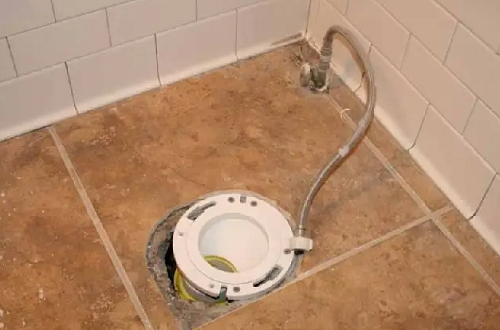When mounting a toilet, the flange is the component that fits between the toilet’s base and the drain pipe. The toilet flange has two essential functions: it holds the toilet securely to the floor and connects your toilet to the drainpipe that empties into the sewer line.
An offset toilet flange is a specialized type of flange that allows you to move your toilet some extra inches on either side. This flange type is ideal when the drain pipe is not lined up directly under the center of the top opening.
Without an offset toilet flange, you’d have to reconstruct the waste water pipe or make a new toilet hole on the floor in such situations. That said, homeowners may face offset toilet flange problems while using or installing this ingenious solution.
This article explores offset toilet flanges. We’ll answer questions such as; what is an offset toilet flange? Is it ok to use an offset toilet flange in your area? We’ll also look at common offset toilet flange problems users face. Read on.
What Is an Offset Toilet Flange
Sometimes when installing a new toilet in your bathroom, a standard toilet flange is not an option due to the placement of the drain pipe. You’ll end up mounting the toilet awkwardly, usually too close or too far from the wall.
The solution in this situation is an offset toilet flange. Unlike a normal toilet flange — centered on the top opening of the drain pipe — an offset flange lets you shift the location of the toilet.
In other words, an offset toilet flange is a special type of flange that allows you to install a standard toilet on a drainpipe with a non-standard rough-in. Installing an offset flange gives you some extra distance right, left, forward, and backward of the existing drain pipe.
How Far Will an Offset Flange Move a Toilet?
And if you were wondering by how much an offset flange offsets the toilet, it’s only by a couple of inches in any direction — but you can also get a 3 inch offset toilet flange.
Are Offset Toilet Flanges Against Code?
Local building codes vary across the United States. Using an offset flange may or may not be against your area’s building codes, but it’s not always straightforward. There are no building codes that specifically prohibit the use of offset flanges.
However, many local building codes require fixtures to be correctly vented. An offset flange could interfere with venting. In that case, using an offset flange when mounting a toilet would be in contravention of local building codes.
But sometimes, an offset flange is the only realistic option when mounting a toilet. No need to worry, though. If your offset toilet flange is installed correctly and adheres to the local building codes, you should be fine with the authorities.
Common Offset Toilet Flange Problems
Like other toilet accessories, offset toilet flanges are not flawless. Homeowners can encounter a wide range of issues when using an offset toilet flange with their toilet. Here are some of the most common offset toilet flange problems users experience.
1. Installation Challenges
Right off the bat, you will encounter a few setbacks when mounting a toilet using an offset flange. Unlike a standard toilet flange, offset flanges are slightly more sophisticated and difficult to install. Incorrect installation will often lead to several problems that will pop up over time.
2. Leaking
As mentioned above, poor installation will lead to issues with your offset toilet flange. It’s safe to say that most offset toilet flange problems result from incorrect installation. For instance, your toilet will leak if you don’t anchor the offset flange securely on the floor and seal it properly.
3. Poor Design
So many offset toilet flanges in the market are designed poorly, making them less effective at their job. A suitable offset toilet flange comes with an angular fitting, which ensures a watertight seal to prevent leaking.
4. Clogging
Do offset toilet flanges clog? Some users may argue that an offset toilet flange is more prone to clogging than a regular flange, but that’s incorrect. You will most likely encounter clogging issues with an offset flange if it’s not tightened correctly.
If your offset toilet flange is not tightened well, it may prevent the contents of the toilet bowl from draining. Keep in mind that a lot of things can cause clogging in your toilet. Avoid flushing non-flushable items such as tampons, wet wipes, cotton buds, condoms etc.
How To Install an Offset Toilet Flange
Proper installation is vital to avoid issues down the line when dealing with an offset toilet flange. And as you probably know by now, an offset toilet flange is trickier to install as a novice compared to a standard toilet flange.
However, it’s simple if you are the handy type or have plumbing experience. Additionally, all models include installation instructions in the manual, which you must follow to do it right the first time.
The general steps for installing an offset toilet flange in a concrete floor are as follows:
- Disconnect the water supply to your toilet via the shut-off valve.
- Flush the toilet to empty the bowl and tank.
- Unmount the toilet bowl and carefully move it to a secure location.
- Use a putty knife to scrape the old wax seal off the base of the toilet and discard it.
- Usually, the toilet flange mounts to the floor with four screws. Remove the old flange by unscrewing it from the floor.
- Fit and install your new offset toilet flange. Use included hardware to secure the offset flange to the toilet floor. Be sure to tighten nuts and washers fully.
- Add the new wax ring to the newly installed toilet flange, placing it centrally around the hole.
- Replace the toilet. With your offset flange in place, you can reassemble the toilet and put it back in place.
That’s how to install an offset toilet flange. Be sure to restore the water supply by slowly turning the shut-off valve to open it. Finally, test the toilet to see if everything is working properly with the offset flange.
How To Choose the Best Offset Toilet Flange
Offset toilet flanges come in a variety of shapes, qualities, and materials. And with so many options in the market, deciding on the best offset toilet flange can be challenging. Here are a few tips to help you choose the best offset toilet flange for your toilet.
- Size. An offset toilet flange allows you to rotate your toilet approximately two inches in different directions, but only if it’s the right size. If you choose the wrong size, you won’t be able to position it as intended.
- Quality. Offset toilet flanges are available in a diverse range of qualities. If you pick a low-quality flange, you are more likely to encounter offset toilet flange issues, such as leaking and clogging.
- Angular fitting. One of the critical features of an excellent offset toilet flange is angular fitting. The angular fitting allows the flange to adapt easily to a wide range of drain pipe sizes or shapes so that you won’t need a toilet flange offset adapter.
- Rounded aperture. If you want a good offset toilet flange, choose one with a round appearance on the upper part. A rounded aperture on an offset toilet flange makes it easy to seal with a conventional wax ring.
Conclusion
You may encounter some problems, especially during installation, but an offset toilet flange is the only realistic solution in certain situations. Fortunately, offset toilet flange problems are not as bad as they are made to be and are completely avoidable. If an offset toilet flange is the right fit for your toilet and is installed correctly, you should avoid these issues.



